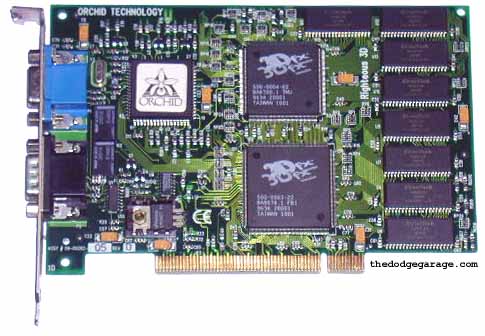
3dfx trivia
To the best of my ability this information is known to be correct, if you have something to add or a correction please drop me a line.
Voodoo Graphics (SST-1)

1) The only reason 3dfx entered the consumer market was the radical drop in ram prices during the 1995-1996 timeframe. The prices dropped enough where the card price went from a staggering $600 to a more reasonable $300. To give you an idea how expensive ram was I remember paying $150 for 4 megs of fast page ram in 1995 and that was a deal at the time!
2) The back of the retail Righteous 3D box shows a "before and after" comparison of MW2 screenshots. Strangely, the after/3Dfx screenshot shown was taken using a Matrox Mystique + Mystique Edition!
3) The first Orchid cards had mechanical relays for taking over the video output, this was later changed to solid state devices. Click HERE to listen!
4) Some early Orchid cards shipped with ram that would not run at spec and cause lockups. Orchids first solution was to release new drivers that reduced the speed of the cards several mhz! They never counted on the early hardware sites and end-users trading notes via the internet and Orchid's reputation & sales suffered.
5) Most people don't know that Voodoo Graphics supports 800 x 600 screen resolution! It has to be an application that doesn't use Z-buffer though.
6) The Voodoo Graphics boards accounted for 85% of the accelerator market in 1996-1997 era.
7) Several arcade games have Voodoo Graphics chipset built onto their PCB.
8) Several commands to the Voodoo Graphics are prefaced with the letters "SST." They are the last initials of the three founders of 3dfx, Chief Scientist Gary Tarolli, Principal Engineer Scott Sellers, and Marketing Executive Ross Smith.
9) The SST-1 design supports three TMU's, hence Quantum3D's 4 digit numbering scheme. Since a card with 3 TMU's was never produced the last digit has always been zero as in SB50-4440"
Voodoo Rush (SST-96)
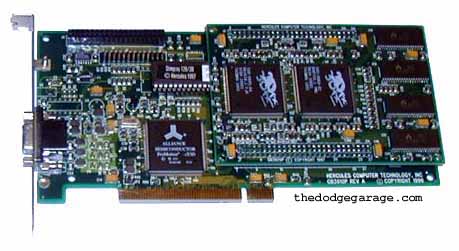
1) Hercules debuted the first Rush board, aka the Sandwich and it performed about 10% slower then Voodoo Graphics giving 3dfx a black eye. Hercules later came out with a more compact single plane 8 MB board that was clocked 10% faster then normal Rush cards bringing it up to Voodoo Graphics performance levels. The degradation in performance was caused by the need to modify the memory interface for use with a 2D chip.
2) Quantum3D made a Rush board called Ventana 50 and another called MGV-PCI. The MGV-PCI was used in Quicksilver arcade systems as a 2D only device!
3) The second chip in the Voodoo Rush chipset is the TMU from Voodoo Graphics.
Voodoo 2 (SST-2)
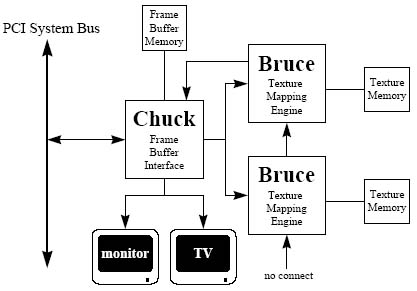
The Voodoo 2 FBI chip was referred to as Chuck, a TMU as Bruce.
1) Voodoo 2 chipsets were in such hot demand that the only two OEM's that received chipsets upon release were Creative Labs and Diamond Multimedia. It would be weeks if not months before 3dfx could ramp up production enough to supply everyone who wish to purchase them.
2) Several arcade consoles use a Quantum3d 90-2440 Voodoo 2 based PCI card.
3) The Voodoo 2 chipset supports SDRAM or SGRAM.
4) A single Voodoo 2 TMU supports 2, 4, 8 or 16 MB of ram
5) A Voodoo 2 can also be run with a single, two or three TMU units.
6) Rumor- Someone from 3dfx in Sept. 1998 floated the idea of a revision 3.0 version of the Voodoo II with 125mhz ram clocked at higher speed then 90 mhz default. This might have been considered a filler before the Voodoo 3 was released or simply the marketing department playing mind games.
Voodoo Banshee
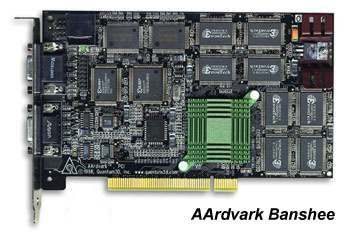
Quantum3D made Banshee cards called Raven, Ventana, Phoenix and Aardvark.
1) The first Banshee cards ran so hot that 3dfx considered adding a heat spreader to the back of the card.
2) According to the hex code in the Banshee bios file the chip supported 4 MB!, 8 MB and 16 MB of ram.
3) The arcade game "SPORTSTATION - NBA SHOWTIME/BLITZ 2000" uses a Quantum3d Banshee card.
4) The Quantum3D Banshee based AArdvark can output to CGA/EGA monitors with automatic 2x anti-aliasing.
Voodoo 3
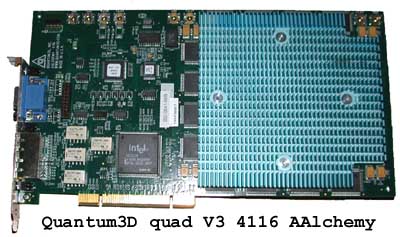
Quantum3D made a quad chip Voodoo 3 board called AAlchemy 4116.
1) Code named "Avenger" the Voodoo 3 was originally going to be called Banshee II but for marketing reasons the Voodoo name was utilized. The official name change to Voodoo 3 occurred on November 17th 1998.
2) The entry level boards were suppose to be clocked at 125 mhz but due to upcoming competition and better then expected chip yields was bumped to 143 mhz.
3) According to internal documents the Voodoo 3 would also support as little as 4 MB of ram!
4) There was a unique Voodoo 3500-TV version sold though Falcon Northwest computers that had 5 ns ram and ran at 200 mhz. The F.N.W. 3500 SE was the first video card to break 400 Megatexels a second mark.
5) Compaq sold two unique versions of the Voodoo 3- A 125 mhz part with no heatsink and a 183 mhz part with no TV tuner.
6) Asus sold 3dfx made, Asus branded Voodoo 3 cards bundled with motherboards for markets outside North America.
7) If you watch the screen of the arcade game Midway Artic Thunder while it is in "display" mode every few minutes the Quantum3D logo is displayed. This console game is powered by a Quantum3D GRAPHITE system which has an Intel P3 CPU and a Voodoo 3 video card.
8) Quantum3D made three Voodoo 3 boards called Ventana 3500 and one of them was a 3D only board.
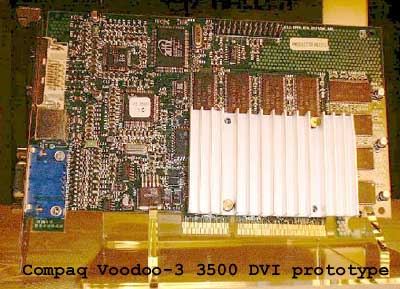
9) The initial Voodoo 3 spec included a Flat Panel Interface (DVI) and early press reports indicated the 3500 would be sold with a DVI connector. Shown above is a later prototype made for Compaq that never went into production.
10) Rumor- 3dfx was taking so much flack from the press in regards to the Voodoo 3's lack of 32-bit rendering or AGP x 4 support that someone threw out the factoid in March of 1999 of a Voodoo 3 4000 that would have both features. The "V3-4000" would be released sometime "late-summer" of 1999, which of course never happened, nor was there ever a prototype to be seen. Chances are this was just another marketing ploy to gain time and get the press off 3dfx's back till the VSA-100 chips were announced at Comdex '99
VSA-100 (Voodoo 4/5/6)
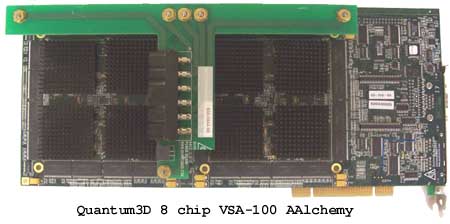
1) Code named "Napalm," the VSA-100 chip was the first 3dfx chipset to support textures larger then 256 x 256 and 32 bit color.
2) One of the reasons Voodoo 4/5 was delayed was somebody apparently forgetting to go to Asia to pickup the first batch of completed VSA-100 chips. (Source: Firing Squad)
3) Another example was a mistake in QA. Quake3 was repeatedly locking their system on Voodoo5 and they could not determine the cause. After a two-week delay the cause was found to be a bad hard-drive Ghost image that was repeatedly used. (Source: Firing Squad)
4) Rumor has it one of the reasons 3dfx closed was that they were being pressed for payment by ram suppliers. The Voodoo 5500 cards use lots of ram and circuitry and the cards did not sell as fast or as much as 3dfx projected leaving them with lots of parts on hand.
5) Powercolor and Quantum3d are the only other two *major* vendors to make boards based on VSA-100 chips. In the Asia market small vendors like Chance, Evate, Meditech and Speed either manufactured or sold re-branded VSA-100 based boards
6) The Quantum3D AAlchemy based on the VSA chipset can have as many as 4 boards with 8 VSA-100 chips each.
7) There is no Voodoo 5-6500, it was a mistake by a tech-site in Japan covering Comdex'99. The non-functional quad VSA-100 board shown at Comdex '99 is a V5-6000. The design was never meant to be functional but was done for "the dog and pony show" as the PCB designer states.
8) The V4-4500 shown at Comdex '99 is a Compaq no-tuner 3500 with a VSA-100 decal on the Voodoo 3 chip.
9) The V5-6000 shown at Comdex had 4 V3-3500 chips on it hiding under the VSA-100 decals.
Rampage & Sage
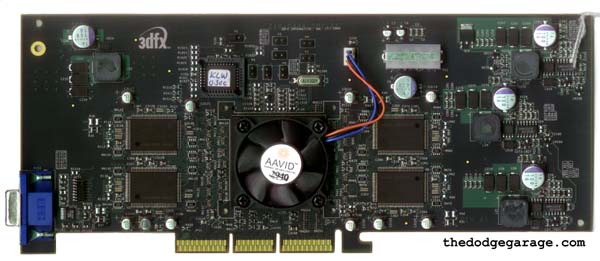
1) The Rampage chip was also known as VSA-200 and would be the basis of a new generation of boards. A board with a single Rampage chip was called Specter 1000. If a board had a single Rampage chip and Sage transformation and lighting unit it would have been a Specter 2000. A board with TWO Rampages and ONE Sage would have been a Specter 3000. There is also mention of a Specter 4000 with FOUR Rampage chips.
2) Prototype Rampage based boards were up and running Quake 3 mere days before 3dfx closed their doors.
3) Interesting bug in Rampage chip- The DAC was flipped, reversing the color channels. One possible reason it was not detected is because this was one of the few places on the chip that had not been simulated. The temporary fix was an interesting little board that was attached between the monitor cable and VGA connector. It flipped all the color channels, making it display correctly.
4) Two or three Rampage based boards are known to be in "circulation," one is known to function.
5) Rampage is a code name for the chip, Habanero was it's predecessor (Rampage with 256 bit DDR memory bus). SAGE is a code name for the T'n L chip (lead engineer "Captain Inverter") SPECTER is a code name for the board (SPecial Executive for Control, Terrorism, Extortion, and Revenge.) Name was picked by the boards designer Brian. (Trivia from Hank Semenec, ex-3dfx engineer)
6) No SAGE chips were known to have been made it onto boards, rumor has it the first test samples showed up.. just days after 3dfx closed their doors.
Daytona (VSA-101)
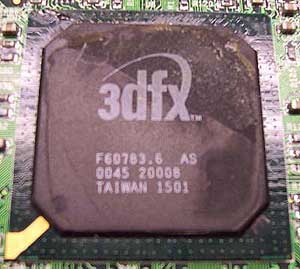
1) The Daytona was the first .18 micron die chip made by 3dfx, it's power consumption is so low that it can be operated as high as 180 mhz with no heatsink.
2) The Daytona was the first chip from 3dfx to support DDR ram.
3) According to this Daytona's bios and a different configuration Daytona card's bios the chip supports SDRAM, SGRAM, SDR & DDR ram in the following sizes- 4, 8, 16, 32, 64, 128 and 256 MB.
4) The Daytona was primarily going to be aimed at the low cost and OEM market segments where it's flexible memory interface and low power consumption would be to it's advantage.
5) The Daytona was also known as VSA-101 and Napalm2.
6) One "hot rod" Daytona with 4 ns ram has been clocked at an astounding 270 mhz by a 3dfx engineer.